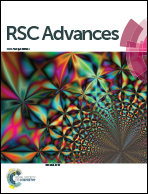In-plane rotation and transition from rectification to bipolar resistive switching in ZnO/SrTiO3:Nb heterojunctions by substrate pretreatment
Abstract
The growth behavior and electrical transport properties of ZnO films was found to be strongly dependent on the deionized water soaking treatment of 0.7 wt% (111) SrTiO3:Nb substrates. Comparing the ZnO films on soaked SrTiO3:Nb substrates with those on unsoaked ones, the out-of-plane orientation of ZnO films are both along the c-axis, while there is an in-plane rotation of ZnO thin films. According to the variable frequency capacitance–voltage measurements, a much higher interface state density is found in the ZnO/soaked-SrTiO3:Nb heterojunction than that in the ZnO/unsoaked-SrTiO3:Nb heterojunction. Moreover, a rectification and bipolar resistive switching effect were observed in the ZnO/unsoaked-SrTiO3:Nb and ZnO/soaked-SrTiO3:Nb heterojunctions, respectively. The transition from rectification to a bipolar resistive switching effect can be ascribed to an increase of oxygen vacancies, the migration of which plays an important part in the resistive switching.



 Please wait while we load your content...
Please wait while we load your content...